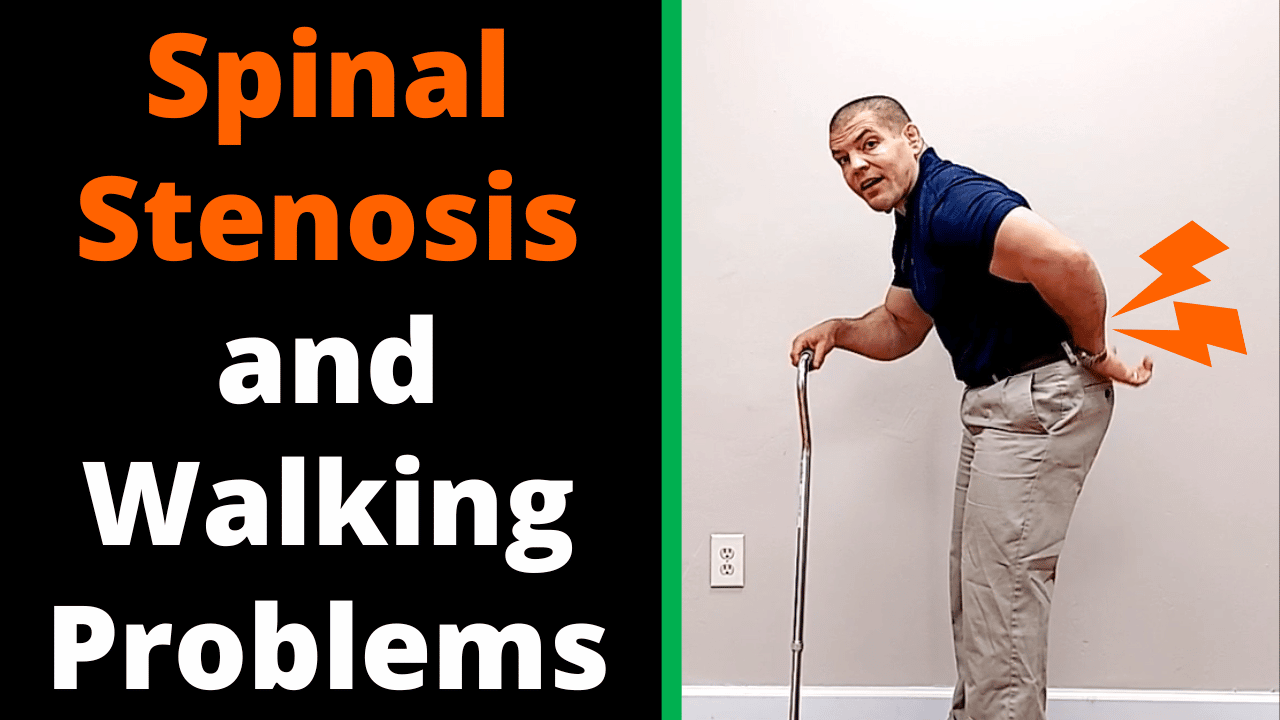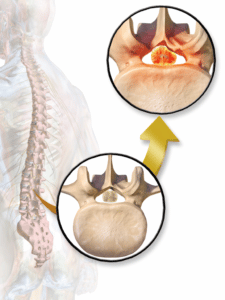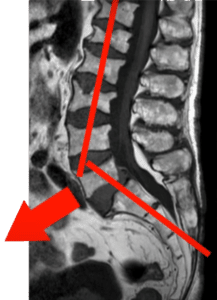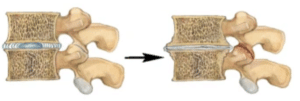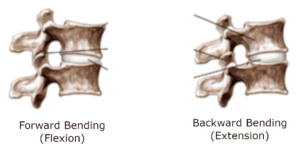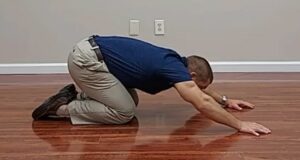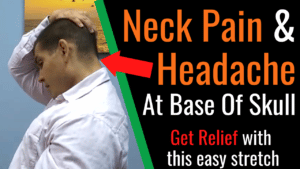Spinal Stenosis And Walking Problems Go Hand In Hand
In fact, walking problems are the most common complaint among people with spinal stenosis. Watch the video to learn tips to walk longer with less pain.
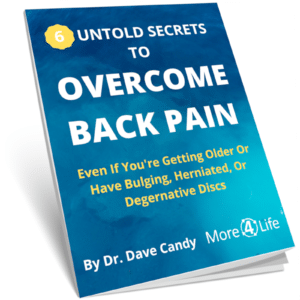
Why Does Spinal Stenosis Cause Walking Problems?
Spinal stenosis pinches the nerves that go down into the legs, or sometimes, the spinal cord itself.
This in turn can cause walking problems such as:
- Leg fatigue
- Legs feeling heavy
- Back and/or leg pain
- Numbness, tingling, or weakness in your legs.
- Feeling unsteady or actually falling
How exactly spinal stenosis pinches your nerves depends on what type of spinal stenosis you have.
2 Types Of Spinal Stenosis That Cause Walking Problems
There are two type of spinal stenosis that commonly cause walking problems:
- Central canal stenosis
- Lateral stenosis (foraminal stenosis)
Central Canal Spinal Stenosis
The canal where the spinal cord runs can narrow as you age. This is referred to as central canal stenosis.
When this happens, it can put pressure on your spinal cord and make your legs feel tired or weak when standing or walking for a long period of time.
What causes central canal spinal stenosis?
Central canal stenosis can be causes by bone spurs that develop around the inside of the vertebrae. If these bone spurs get too big, the only treatment for them truly is surgical.
The most common surgery for spinal stenosis is called laminectomy. The surgeon removes a piece of bone (the lamina) from the involved vertebrae in order to "decompress" the spinal cord.
Most of the time, surgery isn't needed for central canal stenosis
Surgery is the extreme case though. If there's only a very small bone spur you can often do things non-surgically to maximize the space that IS left in the canal and help walking problems.
Central canal spinals stenosis from a slipped disc
The more common cause of central spinal stenosis is one vertebrae, "slipping" forward on another. This is called a spondylolisthesis.
In this case one vertebrae slides forward on the other and it functionally (not structurally) narrows the spinal canal.
The good news about this is that you can do things to correct this type of a functional stenosis.
We'll get to how to do that in just a minute.
But first a bit about the other type of spinal stenosis.
Lateral (Foraminal) Spinal Stenosis
Lateral stenosis is where the intervertebral foramen become narrowed and pinch the nerve roots that come out of the spine. This often occurs as a result of degenerative disc disease.
As your discs lose height, the spaces between the vertebrae gets smaller causing spinal stenosis and walking problems.
Leaning backward can further pinch your nerves
As shown below, when you bend your spine backwards the foramen where your nerves come out gets even smaller.
Therefore, you should avoid leaning too far backwards if you have degenerative disc disease or spinal stenosis.
Excessive bodyfat can also affect your walking
The more weight you carry, particularly in your belly, the more compression that is placed on your spine.
More abdominal fat means more compression on your vertebrae which can further compress your nerves if you have spinal stenosis.
Furthermore, because your belly is in front of your spine, it pulls you spine into more extension. As described above, this further narrows the spaces where your nerve roots exit your spine.
As a result, proper diet and exercise are essential to relieving pain from spinal stenosis.
However, diet is the much larger factor, especially since it may be difficult or painful to walk very far for exercise.
Using a recumbent bike is a great form of exercise for people who have trouble walking due to spinal stenosis.
How To Relieve Walking Problems From Spinal Stenosis
As noted above, leaning backward is bad for both central canal stenosis as well as lateral stenosis.
Conversely, leaning forward slightly when walking helps open both the central canal as well as the spaces where your nerves exit your spine.
This is why a lot of older adults with spinal stenosis walk bent forward... because it feels better.
However, their [children, spouse, physical therapist, doctor, etc.] keep telling them to stand up straight.
But that actually makes the problem worse, because it further narrows the spaces in the spine.
And remember, "stenosis" means narrowing.
Now you may think that walking bent forward makes you look old. However, there are two things to keep in mind:
- You probably don't look as bent over as you feel.
- Would you rather "look old" and get to do the things you enjoy, or miss out on all of the fun and stay inside where no one can ever see whether or not you "look old"?
Problems Walking Upright Due To Spinal Stenosis?
As noted above, you should not try to stand up tall by leaning backward from your lower back if you have spinal stenosis.
However, stretching the muscles groups above and below you lower back can help you stand and walk more upright without overly arching your lower back.
Hip Flexor Stretches
If your hip flexors are stiff, they tilt your pelvis forward causing you to walk more bent over.
Additionally, tight hip flexors make it hard to take normal length steps when walking.
By stretching your hip flexors, you can stand more upright without having to arch your lower back.
Read this post about 4 ways to stretch your hip flexors.
Stretch Your Chest And Lats
Just like your hip flexors cause you to walk bent over from below your lower back, stiff chest and lat muscles can cause you to walk bent over from above.
Read our posts about:
How To Stretch Stiff Pec (Chest) Muscles
How To Stretch Your Lat Muscles
Other Exercises For Spinal Stenosis And Walking Problems
In general, stretches to relieve pain from spinal stenosis involve some form of forward bending, or flattening your spine.
I think the best exercise for spinal stenosis is the child's pose.
It decompresses the nerves in your lower back while also stretching your hip muscles.
However, many people with spinal stenosis also have knee arthritis and may have pain kneeling or difficulty getting up from the floor.
An alternative to the child's pose is forward bending while sitting in a chair.
In fact, many chair yoga poses are good for people with spinal stenosis who have problems standing or walking.
Finally doing a pelvic tilt while standing flattens the curve in your lower back and can create more space for your nerves.
If you'd like to find a exercise program that works best for YOUR particular symptoms, request an appointment with one of our specialists to get a program tailored to your needs.
Is Walking Bad For Spinal Stenosis?
Because walking can be painful for people with spinal stenosis, people often wonder if walking will make spinal stenosis worse.
It won't.
Walking is good for spinal stenosis.
Your nerves need blood flow and oxygen to be healthy, and aerobic exercises such as walking are one of the best ways to accomplish this.
However, you need to pace yourself when walking with spinal stenosis. Walk up to the point where you get tired, and then sit down.
Should I Use A Cane Or Walker For Spinal Stenosis?
Yes, absolutely.
Using a cane or walker helps you improve your balance and prevent falls.
Additionally, you can lean forward on the cane or walker which allows you to take pressure off of the joints and nerves in your back.
Finally, using a rollator walker like the one shown below allows you to sit down whenever you need to.
This way you can walk until you get tired, sit down and take a break, then resume walking.
If you absolutely cannot walk for more than a few minutes, doing water aerobics or riding a recumbent bike are good alternative exercises for spinal stenosis.
Schwinn Fitness 230 Recumbent Bike
36% OffDo Back Braces Help Spinal Stenosis?
Wearing a back brace can help you walk longer if you have spinal stenosis.
In particular a can lift your spine to take the pressure off of your discs and nerves. It basically helps counteract the effects of gravity pushing down on you.
The lumbar decompression braces were developed by a company called Disc Disease Solutions. I recommend either the DDS 300 or DDS G2.
For full disclosure, I am an affiliate for DDS, which means I earn a commission when you SAVE 10% using my code DRCANDY10 when you buy direct from DDS.
Of course just like everything else in the world, you can also find them on Amazon.
DDS G2 Decompression Back Support Belt, ...
$160.00 (as of July 25, 2024 22:42 GMT -05:00 - More infoProduct prices and availability are accurate as of the date/time indicated and are subject to change. Any price and availability information displayed on [relevant Amazon Site(s), as applicable] at the time of purchase will apply to the purchase of this product.)Need Help For Spinal Stenosis?
Tap the button below to request an appointment with one of our back pain specialists
Cervical Spinal Stenosis And Walking Problems
Cervical spinal stenosis refers to stenosis in your neck.
The nerves to your legs come out of your lower back, and the nerves to your arms come out of your neck.
So at first glance, it wouldn't seem that cervical spinal stenosis would have anything to do with walking problems.
Lateral stenosis or foraminal stenosis from degenerative discs in the neck usually causes symptoms in the arm or hand.
However, central canal stenosis in the neck can pinch the spinal cord in your neck, something referred to as cervical myelopathy.
Cervical myelopahty can cause gait problems such as axtaxia - meaning problems walking straight or staggering around likely you're drunk (even if you're completely sober).
What Helps Cervical Spinal Stenosis?
Similarly to lumbar stenosis, bending your neck backwards or looking upward makes the problem worse.
In fact, people with cervical spinal stenosis often get dizzy or feel unsteady if looking too far upward.
Conversely, keeping your chin down when sitting, standing, and walking can maximize the space available in the spinal canal.
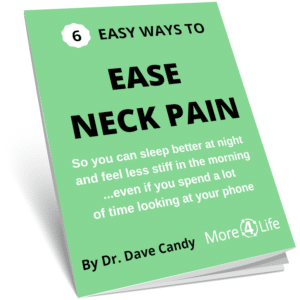
Exercises For Cervical Spinal Stenosis
Largely, keeping your chin down and doing stretches where you bring your chin toward your chest are the best types of exercises for cervical spinal stenosis.
Physical therapy and bracing are the two primary non-surgical treatment options for cervical spinal stenosis. If the condition gets too advanced though, surgery may become necessary.
Need Physical Therapy For Spinal Stenosis?
Request an appointment with one of our specialist physical therapists

